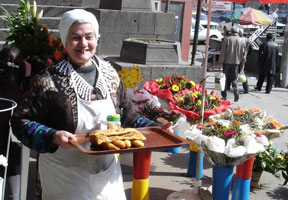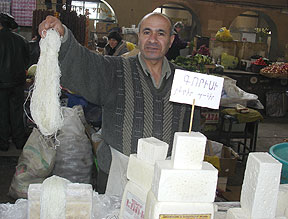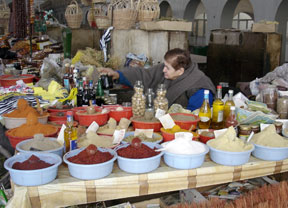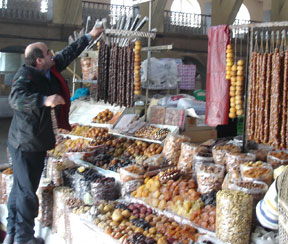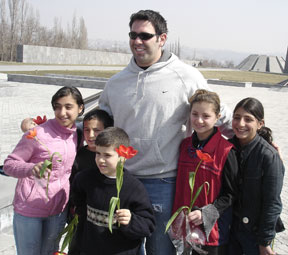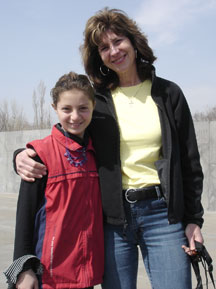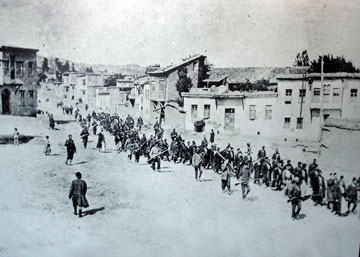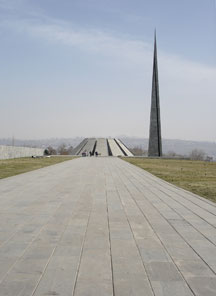| 4 The Long Journey to Armenia ©2006 Lori Bailey Cunningham |
|
||||||||
|
DAY 3: Tuesday • March 14, 2006
-
Shuga Market
-
Genocide Museum
-
Yereblur Veteran's Cemetary
The
Shuga (Indoor Market)
First on the agenda was a trip to the market.
I should inject here that at this time of year (March), there are no tourists in Yerevan. There are business people and NPO's meeting here and there, but no Americans wearing sneakers, jeans and fleece. The dress code for Yerevan, and even the outback, is: spike heeled black boots and skin tight pants for women (they are very fashion conscious and rather provocative dressers); black leather coats, trim haircuts and nice slacks for men.
So into the public market we went looking like quintessential American tourists with giant arrows pointing to our odd outfits. The colors and smells were rich and the vendors were aggressive but very friendly and generous with samples.Dried fruit is big in Armenia, and every stall seemed to contain massive quantities of the item - stuffed with nuts and strung like beads into necklaces, pressed into giant, thin disks (the Armenians invented the fruit roll-up dontcha know) and individual mouth-sized balls covered in everything from coconut to chocolate.
Then there's the cured meat section. Sure the Italians have prosciutto, but the Armenians have this intense, thinly sliced beef called “basturma” that can send your breath into the next city. It comes with advisory notices to consume together with whomever you will be sleeping with that night.
Along with bags of fruit and killer basturma, we purchased flowers to lay on the monument at the Genocide Memorial, Dzidzernagapert (don't ask me how to pronounce it), which was next on our agenda.
The
Armenian Genocide Monument and Museum
The press was present and continued to “pop up” here and there
along our journey. After we parked and began walking towards the simple,
but awe-inspiring structure commemorating the Armenian genocide, a group
of children joined us and stuck close by for the next hour or so as
we took in the sites. Rien has a built-in kid-attractor mechanism -
wherever he goes, youngsters delight in hanging out with him, and he
with them. We laid down our flowers on the memorial which is a circle
built around an ever-burning flame. Then we held hands with our newly
acquired young entourage and that's when I began to feel an upwelling
of emotion.
Now, I must say here that I had no idea that I'd be so affected by the memorial. I have been inclined to think that the Armenians and Turks should just “get over” the past and move on. So when I suddenly got in touch with how my grandpa had to leave his family and country along with millions of others, not to mention the million Armenians that were actually killed in brutal ways, I lost it. I also lost any desire to hide my emotion and just buried my head in my mom's shoulder and sobbed.
The Armenian TV crew captured my emotional response, so me and my make-up streaked face appeared on TV later that evening. So much for my debut in the Armenian media. But hey, it was a real moment, so I have to let that go.
Following my “moment,” we took a guided tour of the museum, which further strengthened my changing view of the genocide as being something to be reckoned with. Oh, the images and stories. Heartbreaking. The exhibit even showed photos of the Turkish troops marching Armenian men out of Kharpert - my grandpa's village. I imagined that my relatives, so many of whom did not make it to the states in time to miss the slaughters, were either in the pack of men being marched or on the sidelines sobbing. Whew.
To further impact our psyches, we went on to see the Yerablur Cemetary, where many soldiers that fought in the war with Azerbaijan in 1988-94 are buried. Several veterans maintain the cemetery as volunteers and were so happy to receive visitors, especially Rien who was so interested in their war stories.
By the time we took our leave, the vets had formally adopted Rien as a “brother in arms” and I was concerned that Rien may actually join the army. As I came to learn, the war with Azerbaijan was, and is, one worth fighting. This does go against my peace-nik nature, but I must concede.
|
The Long Journey to Armenia ©2006 Lori Bailey Cunningham |
